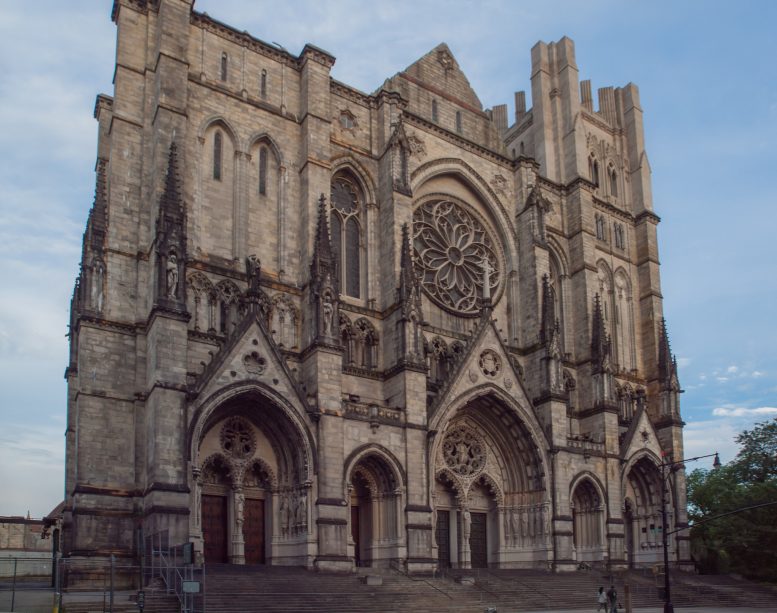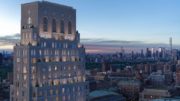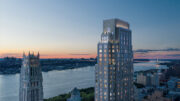What some consider the largest cathedral in the world is one step closer to being designated a New York City landmark. On Tuesday, the Landmarks Preservation Commission held a public hearing on the designation of the Cathedral Church of St. John the Divine, after the property was calendared in July.
Though most know it by that name, its long name is the “Cathedral Church of Saint John: The Great Divine in the City and Diocese of New York.” Located at 1047 Amsterdam Avenue, it is the seat of the Episcopal Diocese of New York.
Work on the amazing Gothic structure started in 1888, with a design by George Lewis Heins and Christopher Grant LaFarge. However, following the death of Heins, Ralph Adams Cram took over the project. The crossing’s dome, originally intended as a temporary roof, was built by vaulted tile ceiling master Rafael Guastavino in 1909.
The 601-foot-long cathedral opened on November 30, 1941. The south bell tower and carvings around the center portal were made by stonemasons trained at the cathedral’s own stone yard, which didn’t open until 1979. The Portal of Paradise, as the Cathedral’s central portal is called, was completed by stone carver Simon Verity between 1988 and 1997. Fire struck the church in 2001, and it reopened in 2008.
The church remains incomplete, which is not unusual for massive religious structures, as most visitors to Antoni Gaudi’s Sagrada Familia in Barcelona know. However, that would make its designation unusual, as buildings are not usually eligible for landmarks designation in New York City until they are 30 years of age.
The property under consideration by the LPC includes the cathedral church as well as six other buildings, which, together, form the Cathedral Close. The other buildings are the Leake & Watts Orphan Asylum building, St. Faith’s House, the Choir School, Synod House, the Deanery, and the Bishops House.
It should be noted that the LPC designated the cathedral, but not its grounds, a landmark in 2003. However, that designation was overturned by the City Council, which must approve all new designated landmarks.
Rev. James Kowalski, dean of the church, testified in support of designation. He said it will be the “next step in celebrating and providing stewardship.” He also noted that over one million visitors and worshippers visit the church each year. Following him in supporting designation were architect Susan Rodriguez of Ennead Architects and preservation consultant Elise Quasebarth of Higgins Quasebarth & Partners.
City Council Member Mark Levine testified in person, as did Andrea Goldwyn of the New York Landmarks Conservancy.
The Historic Districts Council’s Kelly Carroll lamented what has happened while the site sat unprotected:
“Despite three hearings in 1966, one in 1979, and one in 2002, the Cathedral of St. John the Divine nor its Close has ever been designated an official landmark site. HDC has long supported the Morningside Heights community and its decades-long wishes to designate the cathedral and its close. The close is such an integral part of this ecclesiastical complex that the community did not want the cathedral designated without the inclusion of the close, and for good reason. As HDC testified in 2002, ‘There may be room in the cathedral close for additional structures, but those structures must be designed and sited so that they do not compromise the Cathedral itself. These decisions, we feel, are best made by the Commission, after adequate public review. Without designation of the entire site, and with designation of the Cathedral alone, we are troubled by the possibility of the designated landmark being hemmed in to the extent that its preservation is in name only.’
“It is unfortunate that the condominium developments within the close have been completed far ahead of the cathedral’s own repairs and completion. These two high-rise condominiums now occupy the close, which are out of scale, clash in materials, and have troubling proximity to the old cathedral.
“It remains the largest Gothic cathedral in the world and its sheer mass, made of solid stone, is a nod to the cathedrals of the Old World. Just like its European predecessors, which often took hundreds of years to build, this cathedral has entered its third century unfinished. It is comforting knowing that future work to this monument and its campus will benefit from the Landmarks Preservation Commission’s oversight, and be spared of any more aesthetic erosion.”
Laura Friedman, who heads the Morningside Heights Historic District Committee, echoed Carroll’s sentiment, calling the recent construction around the campus the “Penn Station of Morningside Heights.” Preservation consultant Gregory Dietrich of Gregory Dietrich Preservation Consulting rose to complain about how the new construction has marred the view.
Commissioner John Gustaffson, who was married at the cathedral, said the designation will “accept the bitter and the sweet.” Commissioner Diana Chapin said her husband’s grandmother’s memorial service was held there.
LPC Chair Meenakshi Srinivasan called the church “incredibly important” and said designation will “establish the right setting for its protection.”
Subscribe to YIMBY’s daily e-mail
Follow YIMBYgram for real-time photo updates
Like YIMBY on Facebook
Follow YIMBY’s Twitter for the latest in YIMBYnews






What happened?..(public hearing again), in the end of messages I want sweet but not bitter.
Note that the Cathedral of St. John the Divine is the largest Gothic Cathedral in the world, not the largest cathedral. That’s a significant distinction.
The cathedral has entered it’s SECOND century. A large reason for it’s incomplete state can be laid at the feet of those in charge who decided to completely change the design after so much construction was finished. Questions I would have are: Will they have a master plan they have to follow in the future? Will the “temporary” dome be removed? Can buildings on campus that were built on the area needed for the transept be torn down or will they be landmarked?